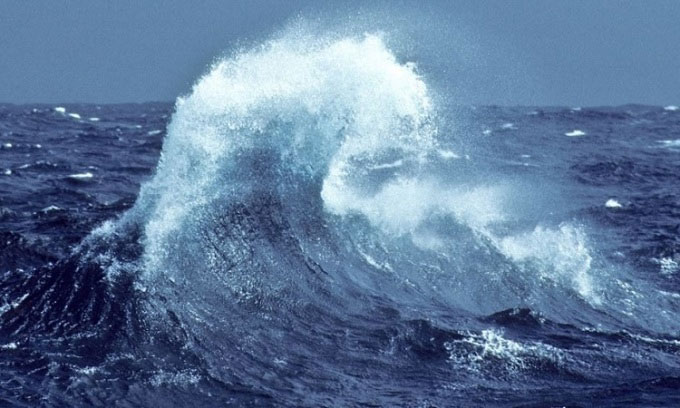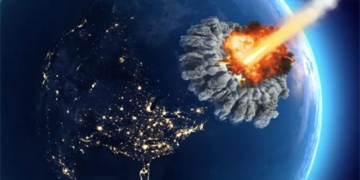Predicting When Killer Waves, the Dangerous Walls of Water as Tall as Skyscrapers, Will Appear Remains a Challenge for Researchers.
In 1826, Captain Jules Dumont d’Urville, a French scientist and naval officer, encountered a powerful storm while crossing the Indian Ocean. He observed a wall of water rising 30 meters above his ship, the Astrolabe. This was one of several waves over 24 meters that Dumont d’Urville witnessed during the storm. One crew member went missing. However, after Dumont d’Urville returned to shore, his account, supported by three witnesses, seemed so bizarre that people dismissed it as delusional.
Scientists of that era believed that waves could only reach heights of about 9 meters, leading to many reports of giant ocean waves in the 19th century being regarded as maritime mysteries. It was only later that researchers realized the very few records available were from sailors who had encountered killer waves, also known as rogue waves, and did not survive to tell their tales.

Killer waves in the Southern Ocean captured from the French icebreaker Astrolabe. (Photo: Veronique Sarano)
Today, killer waves are defined as waves that are more than twice the height of surrounding waves. They can appear suddenly and from any direction. With steep slopes and deep troughs beneath, killer waves resemble a wall of water rising straight from the sea surface. They can occur during storms when the sea is rough, but they have also been recorded in calm waters, making them very difficult to predict.
Scientists recognized killer waves as a real phenomenon in the mid-1990s, but ensuring the safety of seafarers against these waves remains a significant challenge. Although relatively rare, killer waves can cause severe damage to life and property when they strike vessels on the open sea. In the vast ocean, the interaction of multiple forces that lead to the formation of killer waves is challenging to pinpoint. Recently, mathematicians have combined real-time data collected from buoys with statistical models to better understand what causes killer waves to form. Their research could help in predicting killer waves before they strike.
Theories on the Formation of Killer Waves
There are two main mathematical theories explaining the wave motions that lead to the emergence of killer waves. The linear addition hypothesis suggests that waves travel across the ocean at different speeds. When they collide, they amplify, forming rogue waves. The second hypothesis, known as nonlinear focusing, posits that waves group together and transfer energy to each other, leading to the formation of killer waves. The reason researchers cannot be certain is that killer waves are very rare. Even today, the quality of tracking data is quite limited.
“In general, killer waves in the ocean are measured from a buoy at a specific location, making it impossible to know what happens before or after“, says Amin Chabchoub, a physicist specializing in wave research at the University of Sydney in Australia. A study conducted by Chabchoub in 2019 evaluated several observations and models of killer waves. The research team concluded that the mechanisms generating killer waves could vary depending on many factors at sea, referred to as sea state.
To support the limited observations of killer waves, scientists rely on wave tanks. “Laboratory recreations can simulate almost exactly what happens on the ocean surface,” Chabchoub explains. Such experiments can even incorporate ocean currents and wind forces, although controlled environments have their own limitations.
When water is confined in a narrow channel like a wave tank, large waves can form and be observed much more easily. However, such experiments are somewhat unrealistic because waves cannot spread in all directions as they do in the ocean, according to Francesco Fedele, an engineer at the Georgia Institute of Technology.
Developing Prediction Technology
The National Oceanic and Atmospheric Administration (NOAA) in the United States is developing a system that can predict potential hazardous areas in the ocean every hour using the WAVEWATCH III program. The latest version, released in 2019, applies a probability formula developed by Fedele in 2012 to predict extreme marine conditions at specific times and locations. This is a useful tool for mariners to avoid dangerous waters, but it is not sufficient to protect them from suddenly occurring killer waves.
Johannes Gemmrich, a researcher at the University of Victoria in Canada, who analyzed a killer wave near Vancouver Island in 2020, notes that killer waves most frequently occur when waves travel at different speeds and sometimes collide. However, he believes that the asymmetry of ocean waves (where a wave has a higher crest and a lower trough) also plays a significant role.
The scientific community is developing real-time wave prediction technology, but new methods need to be tested under real conditions, which is a significant challenge given the rarity of killer waves. In many cases, the computational process needs to be accelerated to match the speed of the waves. Killer waves can form in just 10 to 15 seconds in rough seas, making it difficult to provide quick and accurate predictions in such a short time frame.
To make predictions, scientists will need a radar system that continuously measures waves near ships, allowing them to run data through a mathematical model to simulate the sea surface at that moment. A model that recalculates sea surface conditions every five minutes could provide relatively accurate predictions of how ocean waves develop in the following minutes. However, such a system has yet to become a reality. “The technology is available. The current challenge is how you can predict quickly enough?”, Fedele emphasizes.


















































